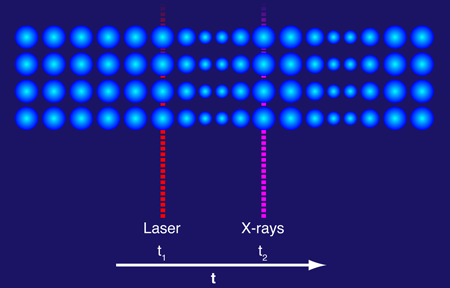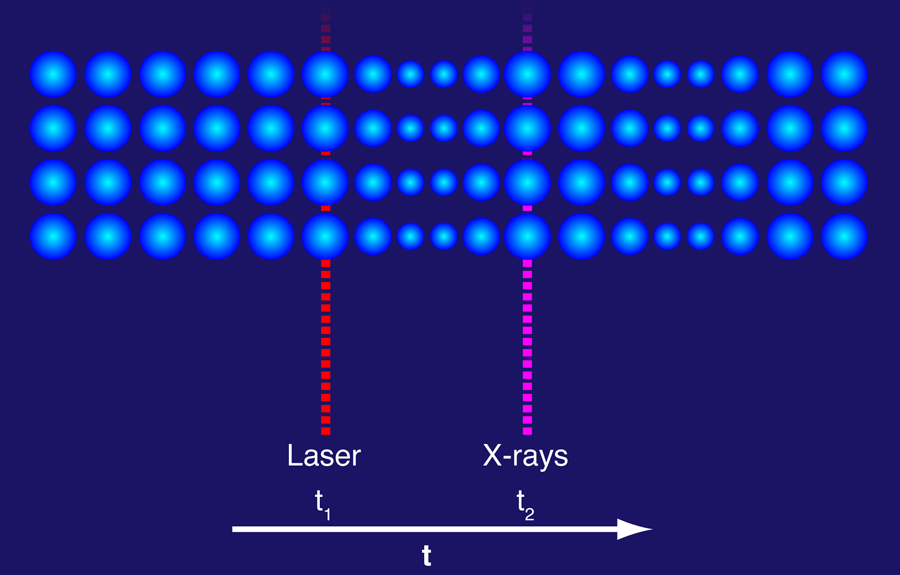Squeezing more out of ultrafast x-ray measurements
Fluctuations are unavoidable in any physical system but they can be the bane of precision measurements. A way around this is to generate what are called squeezed states. In a squeezed state, the uncertainty in one of a pair of conjugate variables (such as position and momentum) can be reduced below the quantum limit, so long as the product of the variables satisfies the Heisenberg relation. In many important applications like quantum information processing [1] and gravity-wave detection [2], the squeezed states correspond to an electromagnetic field. In a paper appearing in Physical Review Letters, Steven Johnson and colleagues at the Paul Scherrer Institut in Switzerland and collaborators in Switzerland, the US, and Ireland are looking at squeezed states in another bosonic field: vibrations in a solid that are excited by light. These squeezed phonons correspond to oscillating fluctuations in the atomic displacements and momenta for a single crystal of bismuth and they are measured directly using femtosecond x-ray diffraction [3] (Fig. 1). Such experiments could have far reaching implications for studying excited state dynamics at ultrafast times and on atomic-length scales, such as in chemical reactions and electronic and vibrational relaxation in solids.
It is well known that the power spectrum of random fluctuations in thermal equilibrium is directly related to the linear response of a system to an external force (this is the famous fluctuation-dissipation theorem). Physicists routinely use this relationship to study dynamics over a wide range of distance and time scales. However, in order to probe displacements on atomic length scales and the fastest vibrations in solids, new techniques are required. Time-resolved x-ray diffraction has proven to be useful for tracking both the average and mean-square displacement of atoms following intense laser excitation [4].
In 1913, Debye explained the effects of the thermal vibrations of atoms on an x-ray diffraction pattern from a crystalline solid [5]. Increasing temperature causes the intensity of a Bragg diffraction peak to go down, but the position and width of the peak remains mostly unchanged. This decrease in Bragg peak intensity—the so-called Debye-Waller effect—depends exponentially on the mean-square atomic displacements relative to the spacing between—and the projection perpendicular to—the atomic planes. In a typical experiment this results in a time-averaged reduction in the area under the Bragg peak that gets more pronounced with both temperature and at higher order reflections.
In their experiment, Johnson et al. exploit the Debye-Waller effect to measure the time-dependence of the mean-square displacements of atoms in pure bismuth that are excited with a laser. In bismuth, intense photoexcitation leads to coherent phonons that oscillate with a high amplitude. (Here, coherent phonon means that the motions of the atoms in each unit cell of the crystal are in phase.) And, the greater the intensity of the excitation source, the lower the frequency of the excited phonon. Johnson et al. excite phonons in bismuth with laser light that has a wavelength much longer than the interatomic spacing of bismuth, so that the optical excitation transfers negligible momentum to the crystal lattice and they can study phonon modes with close to zero momentum. While a number of experimental and theoretical studies of such near-zero-momentum phonon modes have been undertaken in the limit of strong excitation [6], this is the first experiment that directly probes the effect that the laser excitation has on all the phonon modes.
In Johnson et al.’s experiments, the laser excites a substantial fraction of the electrons from the valence to conduction band in a time that is short compared to the period of the fastest vibrations. This suddenly alters the forces between the bismuth atoms and the allowed phonons are no longer those of the equilibrium solid. However, the position and momentum of the atoms cannot respond instantaneously. What follows is that the mean-square amplitudes (and momenta) of individual phonons oscillate at twice the excited state frequency. The atoms oscillate between being, on average, a little closer to their equilibrium positions (with increased spread in momenta) and being a little further from their equilibrium positions (with decreased spread in their momenta). This is what is meant by a squeezed phonon.
At a definite time interval after the laser excitation, Johnson et al. measure the time evolution of a Bragg diffraction peak with short pulses ( ) of x rays (Fig. 1). Since the Debye-Waller factor—and the Bragg peak intensity—depend directly on this modulation of the mean-square displacements that results from the squeezed phonon, the intensity of the Bragg peak oscillates in time with a frequency that is twice the excited state frequency. To see this oscillation, though, requires a major experimental breakthrough to mitigate the effect of the coherent zone-center phonons that would otherwise swamp the squeezing signal. The researchers therefore arrange the x rays to diffract from lattice planes where the displacements associated with the coherent phonon have no effect on the scattering intensity. The results show a clear oscillation in the mean-square displacement that is consistent with near uniform softening of all phonon modes—in other words, with a uniform reduction of the force constants—and are interpreted as the first direct observation of squeezed phonons [7].
Squeezed phonons were first observed in second-order Raman scattering [8], but unlike x-ray diffraction, where the wavelength of the light is close to that of the spacing between atoms, optical measurements provide only an indirect probe of the atomic displacements. In both cases, the measurements sum over a density of phonon states. It is important to note that with the advent of fourth-generation light sources, such as the Linac Coherent Light Source x-ray free electron laser, which began lasing this week [9], researchers will soon be able to extend these types of studies to x-ray diffuse scattering, which is sensitive to the atomic displacement for a particular wave vector. Such experiments will allow us to measure changes in the interatomic forces across all length scales.
References
- Y. Yamamoto and H. A. Haus, Rev. Mod. Phys. 58, 1001 (1986)
- C. M. Caves, Phys. Rev. D 23, 1693 (1981)
- S. L. Johnson, P. Beaud, E. Vorobeva, C. J. Milne, É. D. Murray, S. Fahy, and G. Ingold, Phys. Rev. Lett. 102, 175503 (2009)
- D. A. Reis and A. M. Lindenberg, in Topics in Applied Physics, Vol. 108, edited by M. Cardona and R. Merlin, Light Scattering in Solids IX (Springer-Verlag, Berlin/Heidelberg, 2007)[Amazon][WorldCat]
- P. Debye, Verh. d. Deutsch. Phys. Ges. 15, 678 (1913); 15, 738 (1913); 15, 857 (1913)
- See, for example, M. F. DeCamp et al., Phys. Rev. B. 64, 092301 (2001); M. Hase et al., Phys. Rev. Lett. 88, 067401 (2002); K. Sokolowski-Tinten et al., Nature 422, 287 (2003); E. D. Murray et al., Phys. Rev. B 72, 060301 (2005); E. S. Zijlstra, 74, 220301 (2006); D. M. Fritz et al., Science 315, 633 (2007); E. D. Murray et al., Phys. Rev. B 75, 184301 (2007); S. L. Johnson et al., Phys. Rev. Lett. 100, 155501 (2008)
- Experiments on the ultrafast disordering of InSb have been interpreted in the context of squeezed modes from the uniform softening of a simple Debye model for the phonon dispersion as well as a density functional perturbation theory approach; however, the experiments did not show oscillations in the Debye-Waller factor. P. B. Hillyard, et al., Phys. Rev. Lett. 98, 125501 (2007); P. B. Hillyard, D. A. Reis, and K. J. Gaffney, Phys. Rev. B 77, 195213 (2008)
- G. A. Garrett, A. G. Rojo, A. K. Sood, J. F. Whitaker, and R. Merlin, Science 275, 1638 (1997)
- http://lcls.slac.stanford.edu/





